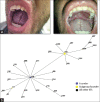Persistence of Clonal Azole-Resistant Isolates of Candida albicans from a Patient with Chronic Mucocutaneous Candidiasis in Colombia
- PMID: 32165797
- PMCID: PMC7045761
- DOI: 10.4103/jgid.jgid_74_19
Persistence of Clonal Azole-Resistant Isolates of Candida albicans from a Patient with Chronic Mucocutaneous Candidiasis in Colombia
Abstract
Purpose: The present article describes retrospectively a case of a patient with chronic mucocutaneous candidiasis (CMC) who presented recurrent Candida albicans infection since he was 6 months old. We obtained 16 isolates recovered during a 4-year period. Our purpose was to determinate the susceptibility, genotyping, and the pathogenicity profile in all the isolates.
Methods: Sixteen C. albicans were isolated from a 25-year-old male with several recurrent fungal infections admitted to Hospital. The isolates were recovered during 4 years from a different anatomical origin. We typified them by multilocus sequence typing, also we evaluated susceptibility to fluconazole, itraconazole, voriconazole, posaconazole, isavuconazole, caspofungin, and amphotericin B by microdilution method and we also test the pathogenic capacity in the Galleria mellonella model.
Results: Genotyping of all clinical isolates showed the persistence of the same diploid sequence type (DST). Isolates changed their susceptibility profile over time, but there were no significant statistical differences in pathogenicity.
Conclusion: Herein, a persistent clonal isolates of C. albicans (DST 918) in a patient with CMC, showed changes in its susceptibility profile after several antifungal treatments acquiring gradual resistance to the azole drugs, which did not affect their pathogenicity.
Keywords: chronic mucocutaneous candidiasis; multilocus sequence typing; Candida albicans; Galleria mellonella; drug susceptibility.
Copyright: © 2020 Journal of Global Infectious Diseases.
Conflict of interest statement
There are no conflicts of interest.
Figures



Similar articles
-
Epidemiology and Antifungal Susceptibility of Candida Species Isolated from 10 Tertiary Care Hospitals in Iran.Microbiol Spectr. 2022 Dec 21;10(6):e0245322. doi: 10.1128/spectrum.02453-22. Epub 2022 Nov 29. Microbiol Spectr. 2022. PMID: 36445122 Free PMC article.
-
Iranian HIV/AIDS patients with oropharyngeal candidiasis: identification, prevalence and antifungal susceptibility of Candida species.Lett Appl Microbiol. 2018 Oct;67(4):392-399. doi: 10.1111/lam.13052. Epub 2018 Aug 16. Lett Appl Microbiol. 2018. PMID: 30019443
-
Microbiological screening of Irish patients with autoimmune polyendocrinopathy-candidiasis-ectodermal dystrophy reveals persistence of Candida albicans strains, gradual reduction in susceptibility to azoles, and incidences of clinical signs of oral candidiasis without culture evidence.J Clin Microbiol. 2011 May;49(5):1879-89. doi: 10.1128/JCM.00026-11. Epub 2011 Mar 2. J Clin Microbiol. 2011. PMID: 21367996 Free PMC article.
-
Antifungal drug resistance in pathogenic fungi.Med Mycol. 1998;36 Suppl 1:119-28. Med Mycol. 1998. PMID: 9988500 Review.
-
Candida and candidaemia. Susceptibility and epidemiology.Dan Med J. 2013 Nov;60(11):B4698. Dan Med J. 2013. PMID: 24192246 Review.
Cited by
-
Emergence and circulation of azole-resistant C. albicans, C. auris and C. parapsilosis bloodstream isolates carrying Y132F, K143R or T220L Erg11p substitutions in Colombia.Front Cell Infect Microbiol. 2023 Mar 21;13:1136217. doi: 10.3389/fcimb.2023.1136217. eCollection 2023. Front Cell Infect Microbiol. 2023. PMID: 37026059 Free PMC article.
-
Inhibitory Effects and Mechanism of Action of Elsinochrome A on Candida albicans and Its Biofilm.J Fungi (Basel). 2022 Aug 11;8(8):841. doi: 10.3390/jof8080841. J Fungi (Basel). 2022. PMID: 36012829 Free PMC article.
-
In Vivo Microevolutionary Analysis of a Fatal Case of Rhinofacial and Disseminated Mycosis Due to Azole-Drug-Resistant Candida Species.J Fungi (Basel). 2023 Aug 2;9(8):815. doi: 10.3390/jof9080815. J Fungi (Basel). 2023. PMID: 37623586 Free PMC article.
-
Exploring the Potential Mechanism of Action of Piperine against Candida albicans and Targeting Its Virulence Factors.Biomolecules. 2023 Nov 30;13(12):1729. doi: 10.3390/biom13121729. Biomolecules. 2023. PMID: 38136600 Free PMC article.
References
-
- Milner JD, Holland SM. The cup runneth over: Lessons from the ever-expanding pool of primary immunodeficiency diseases. Nat Rev Immunol. 2013;13:635–48. - PubMed
-
- Carey B, Lambourne J, Porter S, Hodgson T. Chronic mucocutaneous candidiasis due to gain-of-function mutation in STAT1. Oral Dis. 2019;25:684–92. - PubMed
-
- Bhattad S, Dinakar C, Pinnamaraju H, Ganapathy A, Mannan A. Chronic mucocutaneous candidiasis in an adolescent boy due to a novel mutation in TRAF3IP2. J Clin Immunol. 2019;39:596–9. - PubMed

